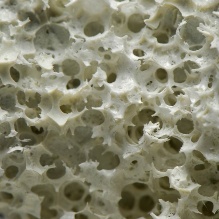Solid concrete components always exhibit very inhomogeneous stress distributions inside them under the various loading scenarios. In some cases, individual areas are subjected to little or no stress. The material present there is therefore actually superfluous.
With the technology of Functionally Graded Concrete, it is possible to optimize the interior of the component. Properties such as strength, density or even thermal conductivity are adapted to the actual material level required by varying the mortar and concrete composition and by the lightweight aggregates, pores and voids introduced into the component. Concrete is only used inside the component where it is actually needed. The result is components with a significant reduction in mass and therefore weight compared with solid components - with the same functionality and performance.
The production of lightweight, often geometrically and topologically complex concrete structures is still labour-intensive, wasteful, and accounts for up to two-thirds of the production budget. The current project examines how resource-efficient structures can be realised with and through sustainable manufacturing methods, as well as which architectural potential they can unlock. The research focuses on the zero-waste production of lightweight concrete structures using water-soluble sand formwork systems. It explores how additive manufacturing of recyclable formwork materials enables maximum freedom in structural design while avoiding production waste by keeping resources in closed-loop production as long as possible.

Lucio Blandini
Prof. Dr.-Ing. M.Arch.Director




